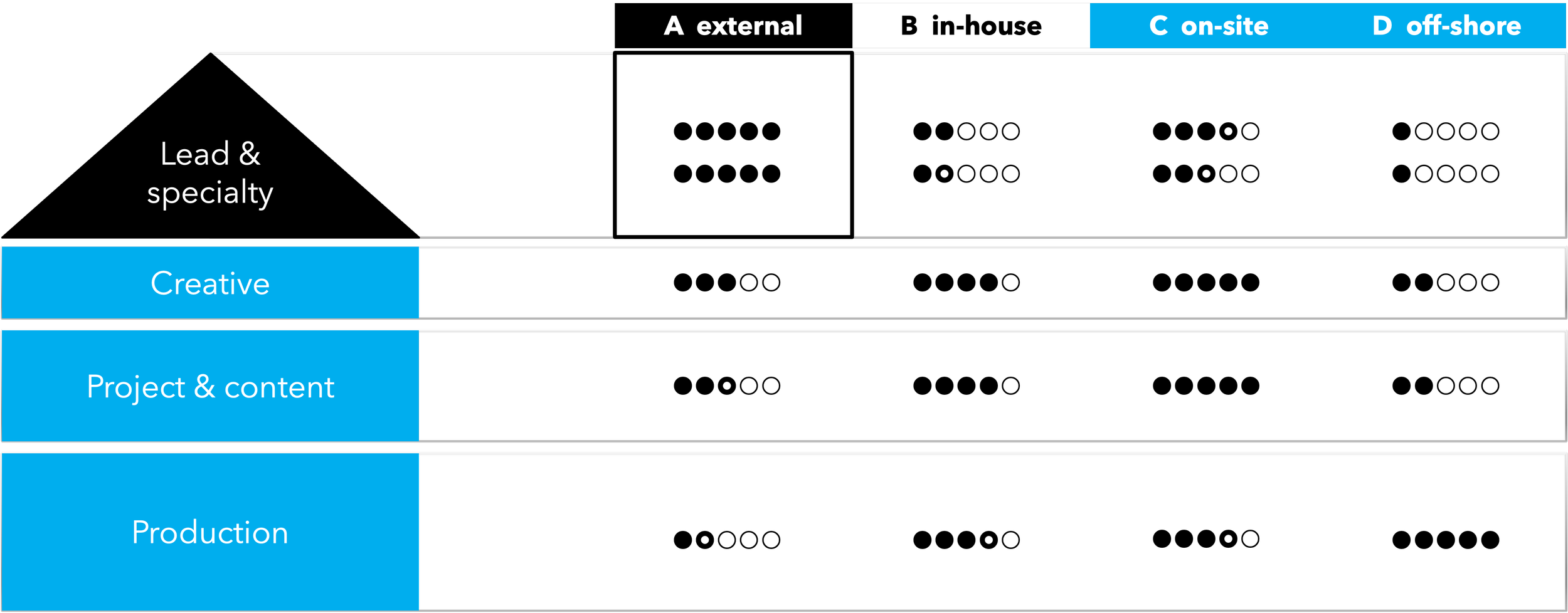Flex Your Marketing Muscle: In-House Meets Outsourced in the Elastic Future of Marketing
As businesses navigate the complexities of digital transformation, the need for flexibility and scalability in marketing is becoming increasingly evident. This evolution is leading companies to explore hybrid models, merging the strengths of in-house teams with the expansive capabilities of external agencies.
Historically, businesses have grappled with a choice: build an in-house team that deeply understands the brand but may lack external perspectives or hire external agencies for their fresh insights but with potential disconnects in company culture. This dichotomy often resulted in challenges regarding career development, creative constraints, and resource management. The "In-house Agency as a Service" model ushers in a transformative phase in marketing management. It combines the close familiarity of in-house teams with the wide-ranging expertise and scalability of external agencies. This fusion meets contemporary businesses' needs for adaptable and efficient marketing strategies. As businesses traverse the evolving digital terrain, adopting such forward-thinking models becomes crucial for effectively meeting the challenges and capitalizing on the opportunities inherent in digital marketing.
The "In-house Agency as a Service" Model Bridging Gaps
The emergence of the "In-house Agency as a Service" model marks a transformative shift in the marketing landscape. It synthesizes the intimate brand knowledge inherent in in-house teams with the diverse expertise and scalability characteristic of external agencies. This innovative hybrid approach ensures a seamless integration into a company's daily operations, offering specialized services that are in complete alignment with the brand's core values and identity.
Crucially, this model overcomes the traditional barriers that have long existed between internal and external marketing efforts. By integrating external agency capabilities within the in-house framework, companies gain the benefit of a broader, more versatile skill set while maintaining the deep understanding and commitment of an in-house team. This duality enables a more adaptive and responsive marketing strategy capable of swiftly navigating the ever-changing business landscape.
Furthermore, the hybrid model enhances collaboration and communication. In-house teams, while possessing a profound understanding of the company's vision and culture, sometimes operate in silos, potentially leading to a lack of fresh perspectives. Conversely, external agencies, though rich in creativity and innovation, may not always grasp the nuanced messaging and ethos of the brand. The "In-house Agency as a Service" model bridges this gap, fostering a symbiotic relationship where both perspectives coalesce, leading to more dynamic, effective, and innovative marketing strategies.
This model represents a strategic fusion of stability and agility, ensuring that marketing efforts are not only deeply rooted in the brand's identity but are also flexible and dynamic enough to adapt to market trends and consumer behaviours.
Scalability and Adaptability
As organizations grow and their market contexts evolve, the demands on their marketing functions intensify and diversify. The "In-house Agency as a Service" model's inherent modularity allows companies to respond with agility, scaling their marketing capabilities to meet fluctuating demands. It effectively provides a tailored marketing solution that can expand or contract in alignment with the company's current requirements.
This adaptability is crucial not only for handling growth but also for navigating the unpredictable shifts in market trends and consumer preferences. By enabling a dynamic adjustment of resources and strategies, businesses can remain competitive and responsive without the logistical and financial constraints of a fixed marketing team or the complexity and inconsistency that often come with a diverse network of freelancers.
The hybrid model's ability to scale lends itself to a more sustainable approach to resource management. Companies can avoid the pitfalls of overstaffing during slower periods or scrambling for resources during peak times. This balanced approach to resource allocation not only optimizes costs but also ensures that marketing efforts are consistently aligned with the company's goals and market opportunities, leading to more effective and efficient marketing operations.
Addressing Operational Challenges
The operational challenges faced by in-house teams, such as heavy workloads, inefficient planning, and struggles with digital enablement, are effectively addressed by the model's inherent flexibility. This adaptability is key in ensuring that in-house teams are not overwhelmed by their tasks. The model's scalable structure allows for adjustments according to varying workloads, enabling teams to efficiently manage and distribute tasks without compromising quality or deadlines. Moreover, specialized teams can be brought in to tackle specific challenges, bringing expertise where it's needed most. This flexible approach to resource allocation and project management significantly enhances the overall efficiency and effectiveness of marketing operations.
Efficiency and Cost-Effectiveness
A major driver towards this model is the quest for efficiency and cost savings. In-house teams often find themselves mired in day-to-day operational tasks, which can stifle creative output. By implementing this model, companies can significantly enhance their operational efficiency, often seeing improvements of 30% to 40%. This boost in efficiency not only frees up time for creative endeavours but also streamlines overall marketing processes.
The model presents a balanced financial approach. It effectively mitigates the high fixed costs associated with maintaining an in-house team and the premium fees typically incurred from external agencies. This strategic financial balancing act has been shown to yield substantial cost savings, with some companies reporting up to a 40% reduction in expenses. These savings are not just a result of reduced expenditures but also stem from a more strategic and efficient allocation of resources, ensuring that every dollar spent on marketing delivers maximum value.
A ZITE Effect?
Faster go-to-market through optimized processes
Professionalizing Marketing Operations
The "In-house Agency as a Service" model elevates marketing operations to a new level of professionalism and strategic relevance. In a marketplace characterized by fragmented audiences and rapidly evolving consumer behaviours, the ability to navigate complexities with precision and agility is paramount. This model empowers in-house teams with advanced tools and clear direction, which are critical in this context.
It offers a suite of sophisticated resources, including intuitive dashboards that enable real-time monitoring and analysis of marketing campaigns and transparency mechanisms that ensure clear communication and alignment across different departments. These tools facilitate a deeper understanding of market trends and customer insights, allowing marketing teams to make data-driven decisions swiftly and confidently.
Furthermore, this model fosters a culture of continuous improvement and innovation within marketing teams. It encourages a shift in perspective, viewing marketing not just as a service to the business but as a strategic partner in driving growth. By integrating advanced analytics, AI-driven insights, and creative collaboration tools, the model enables teams to experiment, learn, and refine their approaches in a dynamic, results-focused environment.
Ultimately, this approach transforms marketing operations from a traditional support function into a strategic entity, capable of driving significant business outcomes. It positions the marketing department as a central hub for customer insights and market intelligence, playing a key role in shaping the company's overall strategy and direction.
In the 'On-Site model, also referred to as the 'In-House-Agency-as-a-Service' approach, external agencies play a pivotal role in both constructing and managing a company's in-house marketing operations. This collaborative model ensures the best of both worlds, with the expertise and flexibility of an external agency seamlessly integrated into the company's core functions. It's a strategic synergy that delivers heightened efficiency and impactful results.
Coupled with the 'On-Site' model, leveraging specialized and creative agencies for overall direction and creative concepts has been recognized as a winning strategy. According to a study conducted by the World Federation of Advertisers, this hybrid approach offers the best of both worlds. It allows companies to harness the focused expertise of specialized agencies for innovative, creative concepts, while the 'On-Site' model ensures seamless execution and integration. This synergy not only drives effectiveness but also enables companies to adapt swiftly to evolving market dynamics, positioning them at the forefront of their industries.
Incorporating Outside Perspectives
A limitation of purely in-house teams is the potential lack of external perspectives and trends. The hybrid model counteracts this by bringing in external creativity, fostering collaboration, and driving innovation. This ensures that marketing campaigns are not only on-brand but also infused with fresh, innovative ideas.
Leveraging Technology Efficiently
In the digital age, choosing the right marketing technology (MarTech) can be daunting. The hybrid model simplifies this by offering a pre-selected set of MarTech and AI tools, making the deployment of marketing assets more efficient and seamless. This approach allows businesses to stay at the forefront of digital marketing without the stress of navigating the vast array of MarTech options.
Considerations for Adoption
The decision to adopt a hybrid marketing model depends on several factors, including the size and needs of the business, budget considerations, and the need for strategic alignment. While it offers numerous benefits, it's important to assess its suitability based on specific business contexts.
The "In-house Agency as a Service" model marks a new era in marketing management. These models offer a blend of intimacy, expertise, and scalability, aligning with the modern business's need for flexibility and efficiency in their marketing operations. As the digital landscape continues to evolve, embracing these innovative models could be key to navigating the challenges and seizing the opportunities of digital marketing.
About the ZITE model
At ZITE, we have developed a unique approach to driving in-house marketing operations with substantial effectiveness and potentially improving marketing operations efficiency by 30% to 40%. We have successfully implemented this strategy with companies like Grundfos, Norlys, Det Nordjyske Mediehus, and Nic Christiansen Gruppen, along with brands such as Jaguar, Land Rover, and Hyundai, across Denmark, Sweden, and Norway. Our approach provides a variety of benefits:
Customized In-House Agency: We build a team from scratch or optimize your existing team, ensuring your new in-house agency is tailored to your future needs. This team works in conjunction with your broader marketing organization and possibly external agencies. Essentially, you maintain ownership of the strategy while we handle the operational aspects.
Innovative Technology and Methods: By gaining access to our market-leading project and reporting system – GOZITE™ – you achieve transparency in all marketing tasks and resources utilized within the organization.
ONZITE Agents: You gain access to an additional and scalable team – a set of extra hands with additional creativity or specialist skills when needed. All agents are cleared and compliant.
Offshore Production Team: Benefit from our own global team of 350 people across Vietnam, Poland, and the UK, all committed to delivering quality work quickly, efficiently, and in a cost-conscious manner.
Savings on External Agencies: By taking over operational tasks from existing agency collaborations, we can significantly reduce your expenses.
Want to learn more about our unique model?
Let’s get in touch
Call me at +45 31241899
or at kasi@zite.agency






